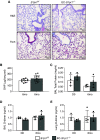Endothelial-Specific Loss of Sphingosine-1-Phosphate Receptor 1 Increases Vascular Permeability and Exacerbates Bleomycin-induced Pulmonary Fibrosis
- PMID: 34343038
- PMCID: PMC8803357
- DOI: 10.1165/rcmb.2020-0408OC
Endothelial-Specific Loss of Sphingosine-1-Phosphate Receptor 1 Increases Vascular Permeability and Exacerbates Bleomycin-induced Pulmonary Fibrosis
Abstract
Idiopathic pulmonary fibrosis (IPF) is a chronic, progressive disease which leads to significant morbidity and mortality from respiratory failure. The two drugs currently approved for clinical use slow the rate of decline in lung function but have not been shown to halt disease progression or reverse established fibrosis. Thus, new therapeutic targets are needed. Endothelial injury and the resultant vascular permeability are critical components in the response to tissue injury and are present in patients with IPF. However, it remains unclear how vascular permeability affects lung repair and fibrosis following injury. Lipid mediators such as sphingosine-1-phosphate (S1P) are known to regulate multiple homeostatic processes in the lung including vascular permeability. We demonstrate that endothelial cell-(EC) specific deletion of the S1P receptor 1 (S1PR1) in mice (EC-S1pr1-/-) results in increased lung vascular permeability at baseline. Following a low-dose intratracheal bleomycin challenge, EC-S1pr1-/- mice had increased and persistent vascular permeability compared with wild-type mice, which was strongly correlated with the amount and localization of resulting pulmonary fibrosis. EC-S1pr1-/- mice also had increased immune cell infiltration and activation of the coagulation cascade within the lung. However, increased circulating S1P ligand in ApoM-overexpressing mice was insufficient to protect against bleomycin-induced pulmonary fibrosis. Overall, these data demonstrate that endothelial cell S1PR1 controls vascular permeability in the lung, is associated with changes in immune cell infiltration and extravascular coagulation, and modulates the fibrotic response to lung injury.
Keywords: lung fibrosis; sphingosine-1-phosphate; sphingosine-1-phosphate 1 receptor; vascular permeability.
Figures









References
-
- Raghu G, Weycker D, Edelsberg J, Bradford WZ, Oster G. Incidence and prevalence of idiopathic pulmonary fibrosis. Am J Respir Crit Care Med . 2006;174:810–816. - PubMed
-
- King TE, Jr, Bradford WZ, Castro-Bernardini S, Fagan EA, Glaspole I, Glassberg MK, et al. ASCEND Study Group A phase 3 trial of pirfenidone in patients with idiopathic pulmonary fibrosis. N Engl J Med . 2014;370:2083–2092. - PubMed
-
- Richeldi L, du Bois RM, Raghu G, Azuma A, Brown KK, Costabel U, et al. INPULSIS Trial Investigators Efficacy and safety of nintedanib in idiopathic pulmonary fibrosis. N Engl J Med . 2014;370:2071–2082. - PubMed
-
- Selman M, King TE, Pardo A, American Thoracic Society; European Respiratory Society; American College of Chest Physicians Idiopathic pulmonary fibrosis: prevailing and evolving hypotheses about its pathogenesis and implications for therapy. Ann Intern Med . 2001;134:136–151. - PubMed
-
- Brown LF, Dvorak AM, Dvorak HF. Leaky vessels, fibrin deposition, and fibrosis: a sequence of events common to solid tumors and to many other types of disease. Am Rev Respir Dis . 1989;140:1104–1107. - PubMed
Publication types
MeSH terms
Substances
Grants and funding
LinkOut - more resources
Full Text Sources
Miscellaneous

